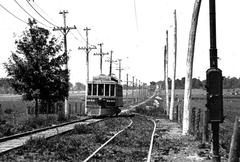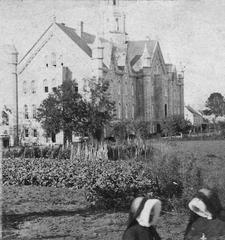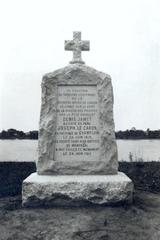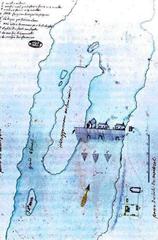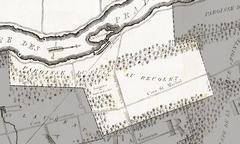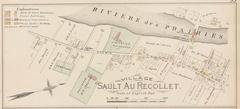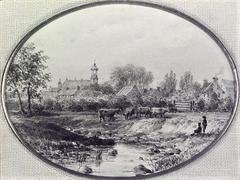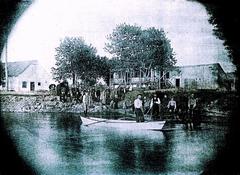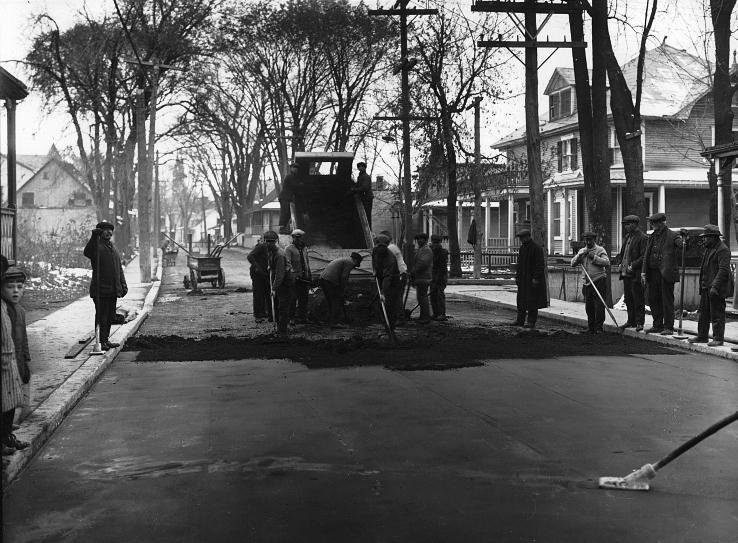
Sault-au-Récollet Montreal: Complete Visiting Hours, Tickets, and Historical Sites Guide
Date: 15/06/2025
Introduction
Sault-au-Récollet, nestled in Montreal’s Ahuntsic-Cartierville borough, is one of the city’s most treasured historic neighborhoods. Renowned for its unique blend of Indigenous heritage, French colonial history, and industrial evolution, Sault-au-Récollet offers a compelling journey through time. Visitors can explore the area’s well-preserved architecture, scenic riverbanks, and vibrant community events, all while gaining insight into Montreal’s multifaceted identity. This guide delivers everything you need to plan your visit—from key historical landmarks and practical travel tips to visiting hours, ticketing, accessibility, and nearby attractions (patrimoine-culturel.gouv.qc.ca, affleckdelariva.com, archivesdemontreal.com, Montreal Historical Sites).
Table of Contents
- Historical Overview
- Visitor Information
- Key Historical Landmarks
- Nearby Attractions and Community Life
- Frequently Asked Questions (FAQ)
- Practical Travel Tips
- Summary and Further Resources
Historical Overview
Indigenous Presence and Early Encounters
Long before European colonization, the Sault-au-Récollet area was a vital portage route for the Algonquin, Iroquoian, and Kanien’kehá:ka (Mohawk) peoples, facilitating trade, fishing, hunting, and camp settlements along the Rivière des Prairies (patrimoine-culturel.gouv.qc.ca, Haunted Montreal). In 1615, Recollet missionaries Denys Jamet and Joseph Le Caron, with Samuel de Champlain, celebrated the first documented mass on Montreal Island here. The area is named for both the “sault” (rapids) and these early missionaries.
The tragic 1625 drowning of missionary Nicolas Viel and his companion Ahuntsic at the rapids—possibly an assassination—left a lasting mark on the site’s memory (Montreal Rampage).
The Sulpician Mission and Fort Lorette
In 1696, the Sulpicians established Fort Lorette at Sault-au-Récollet as a mission and trading post to serve Indigenous communities displaced after the Lachine Massacre. The mission became a focal point for religious and cultural exchange, with a chapel serving both Indigenous and French settlers. Many Indigenous residents later relocated to Oka/Kanesatake (patrimoine-culturel.gouv.qc.ca, Historic Places Days).
Colonial Parish and Village Growth
The parish of La Visitation-de-la-Bienheureuse-Vierge-Marie, founded in 1736, initially held services at Fort Lorette until the construction of the Church of the Visitation (1749–1752)—the oldest surviving church on Montreal Island (affleckdelariva.com). The Sulpicians’ land distributions in 1780 spurred settlement along boulevard Gouin and the riverfront, while early mills established Sault-au-Récollet as a proto-industrial hub (patrimoine-culturel.gouv.qc.ca).
Industrialization and Urban Expansion
The 19th century saw Sault-au-Récollet develop into a service center for rural communities. The tramway’s arrival in 1895 connected the village to downtown, fueling urban growth (archivesdemontreal.com). Milling modernized in 1866, later producing fiberboard and employing many locals (estmediamontreal.com). The village was annexed by Montreal in 1916.
River Transformation and Modern Developments
The construction of the Walker Dam and Rivière-des-Prairies hydroelectric plant (1928–1931) eliminated the historic rapids and altered the river’s ecosystem. Mills operated until the 1960s; today, only the Maison du Meunier remains (estmediamontreal.com). Infrastructure like the Papineau-Leblanc Bridge and boulevard Henri-Bourassa integrated Sault-au-Récollet into the city, while also dividing its historic core (archivesdemontreal.com).
Heritage Conservation
The Société pour la conservation du Sault-au-Récollet, founded in 1976, led the creation of Parc-nature de l’Île-de-la-Visitation and the designation of the village as a heritage site in 1992. The Quebec government officially recognized the area as a historic site in 2018 (patrimoine-culturel.gouv.qc.ca). Today, the park attracts nearly one million visitors annually, offering scenic trails and well-preserved ruins (estmediamontreal.com).
Visitor Information
Getting There and Accessibility
- Public Transit: STM bus lines (including routes 69, 380, 25, 45, and 359) and the Henri-Bourassa metro station (Orange Line) provide easy access (Moovit).
- Cycling: Dedicated bike paths connect Sault-au-Récollet to central and northern Montreal.
- Parking: Limited near park entrances; public transit is recommended during peak times.
- Accessibility: Most parks and public spaces are wheelchair-accessible, with paved paths and ramps. Some heritage buildings have limited access due to preservation requirements.
Visiting Hours and Tickets
- Parc-nature de l’Île-de-la-Visitation: Open year-round, dawn to dusk. Free entry.
- Church of the Visitation: Open Tuesday–Sunday, 10 a.m.–5 p.m. Free entry; special events may require tickets (Community Stories).
- Maison du Pressoir: Tuesday–Sunday, 10 a.m.–5 p.m. Small admission fee; guided tours available.
- Maison du Meunier (Miller’s House): Exterior accessible year-round; interpretive panels provide historical context. Interior visits are not available.
- Cité Historia: Open Wednesday–Sunday, 10 a.m.–5 p.m. Free admission; book tours in advance (Cité Historia).
- Historic Mills: Guided tours (seasonal, May–October) require tickets (approx. CAD 10 for adults).
Key Historical Landmarks
Church of the Visitation
Built from 1749–1752, this church is Montreal’s oldest in its original form. Its French colonial architecture, 19th-century limestone façade, and preserved interior woodwork make it a must-visit. The church hosts regular services, concerts, and heritage events (affleckdelariva.com).
Site des Moulins du Sault-au-Récollet
Dating back to the 18th century, the historic mills complex played a crucial role in the area’s economic development. While most structures were demolished in the 1960s, the Maison du Meunier remains as a testament to local industry (estmediamontreal.com).
Fort Lorette Archaeological Site
Excavations at this site reveal foundations and burial plots from the 18th-century Sulpician mission, offering insight into early colonial and Indigenous histories (affleckdelariva.com).
Parc-nature de l’Île-de-la-Visitation
This 34-hectare urban nature reserve features riverfront trails, historic ruins, and abundant wildlife—blending conservation with heritage interpretation. It is a favorite for walking, cycling, and birdwatching.
Nearby Attractions and Community Life
- Maison du Pressoir: A former cider press, now a museum highlighting the area’s agricultural and industrial heritage.
- Ahuntsic Village: Local cafés, bakeries, and restaurants specializing in Quebecois and French-Canadian cuisine.
- Pont Papineau-Leblanc Graffiti Wall: A legal wall for street art, reflecting Montreal’s creative energy (Vagabundler).
- Cimetière du Sault-au-Récollet: Historic cemetery open daily, offering a peaceful reflection space (Moovit).
- Montreal Botanical Garden and Insectarium: A short drive or metro ride away.
The area hosts numerous cultural events, including open-air concerts, heritage walks, and storytelling sessions. Organizations like the Société d’histoire d’Ahuntsic-Cartierville actively promote local history through community events (SHAC).
Frequently Asked Questions (FAQ)
Q: What are the main visiting hours?
A: Parc-nature de l’Île-de-la-Visitation is open daily from dawn to dusk. Church of the Visitation: Tues–Sun, 10 a.m.–5 p.m. Maison du Pressoir: Tues–Sun, 10 a.m.–5 p.m.
Q: Are there entrance fees?
A: Most outdoor sites are free. Museums and guided tours may require a nominal fee.
Q: Is the area accessible for people with mobility issues?
A: Most parks and main trails are accessible; some historic buildings have limited access.
Q: Are guided tours available?
A: Yes, seasonal tours of the mills, church, and heritage walks are offered. Advance booking is recommended.
Q: Can I bring children or pets?
A: The parks are family-friendly. Pets are allowed on leashes.
Q: What’s the best way to reach Sault-au-Récollet?
A: STM bus and metro are recommended; parking is limited.
Practical Travel Tips
- Plan Ahead: Double-check visiting hours for seasonal changes and special events.
- Dress Appropriately: Weather can be variable; comfortable shoes and layers are advised.
- Public Transit: STM day passes offer unlimited travel in Montreal (Montreal Travel Blog).
- Photography: The riverside, historic mills, and church offer excellent photo opportunities. Respect any signage regarding photography restrictions.
- Sustainability: Use public transit and follow Leave No Trace principles when visiting parks.
- Language: French is predominant, but English is widely understood in tourist areas.
Summary and Further Resources
Sault-au-Récollet is a living tapestry of Montreal’s history, culture, and community. Whether you’re exploring the Church of the Visitation, walking the riverside trails, or joining a guided heritage tour, you’ll encounter the stories that shaped the city. The area’s thoughtful conservation, accessible visitor services, and vibrant local life make it a rewarding destination for all.
For the latest updates, event calendars, and guided tour bookings, visit local tourism websites and download the Audiala app for interactive maps and audio guides. You can also explore related articles on [Montreal Historical Sites Guide], [Top Outdoor Activities in Montreal], and [Montreal Public Transportation Tips].
References and Useful Links
- Sault-au-Récollet Historical Site: Visiting Hours, Tickets, and Montreal’s Hidden Gem, 2025, Société pour la conservation du Sault-au-Récollet
- Church of the Visitation Restoration Project, 2025, Affleck de la Riva Architects
- Chronique Montréalité No. 21: Le Sault-au-Récollet, 2014, Archives de Montréal
- Histoire du Site et des Moulins du Sault-au-Récollet, 2025, Est Média Montréal
- Tracing History to the Fortifications of Sault-au-Récollet, 2025, Historic Places Days
- Société d’histoire d’Ahuntsic-Cartierville Activities and Heritage Events, 2025, SHAC
- Sault-au-Récollet: History, Heritage, and Visiting Guide to Montreal’s Historic Site, 2025, Haunted Montreal and Journal Métro, https://journalmetro.com/local/montreal-nord/591742/lancien-village-du-sault-au-recollet/
- Visiting Sault-au-Récollet: Historic Sites, Hours, Tickets, and Travel Tips, 2025, Montreal City and Cité Historia, https://thepastwhispersorg.blogspot.com/2016/10/the-sault-au-recollets-mills.html
- Your Complete Guide to Visiting Sault-Au-Récollet: Hours, Tickets, Attractions, and Travel Tips, 2025, Moovit, AreaVibes, and Montreal Travel Blog, https://www.areavibes.com/montr%C3%A9al-qc/sault-au-r%C3%A9collet/, https://montrealtravelblog.com/how-to-get-around-montreal/

